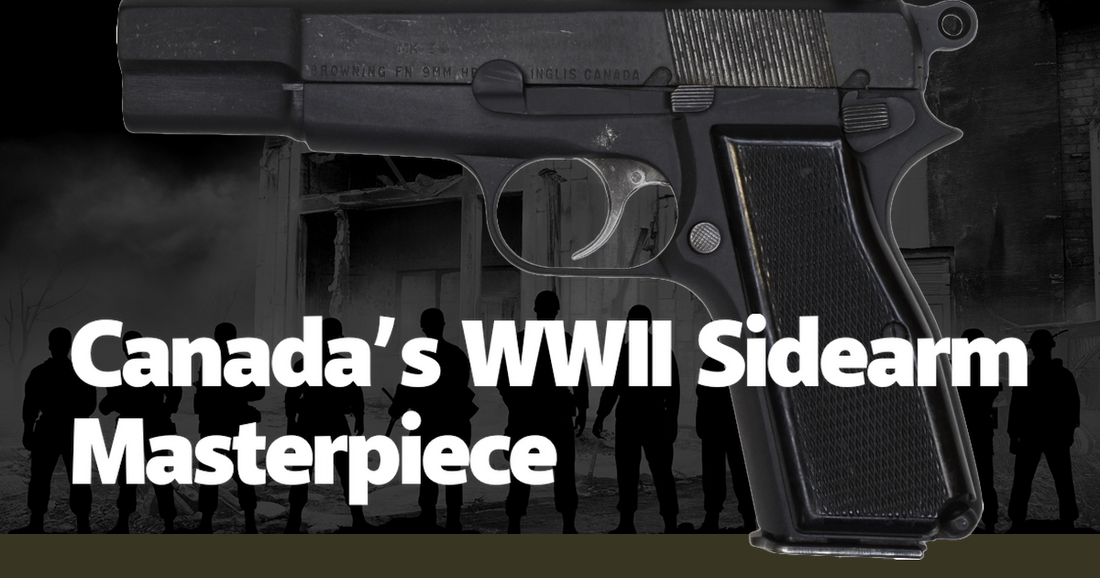In the annals of World War II history, Canada’s contribution is often highlighted through its valiant soldiers, strategic ingenuity, and industrial prowess. Yet, one of the lesser-known but equally significant contributions is the development of the Inglis Hi-Power, a sidearm that became a symbol of Canadian craftsmanship and military acumen. This pistol, officially designated as the Browning Hi-Power, was manufactured under license by the John Inglis and Company in Toronto. It was not just a weapon but a testament to Canada’s ability to produce high-quality military equipment under the pressures of global conflict.
The origins of the Inglis Hi-Power can be traced back to the genius of John Moses Browning, an American firearms designer whose innovations revolutionized modern firearm design. Browning’s original Hi-Power design, completed posthumously by Dieudonné Saive of Fabrique Nationale (FN) in Belgium, was a marvel of engineering. It featured a 13-round magazine, nearly double the capacity of contemporary pistols, and a robust design that could withstand the rigors of combat. When Belgium fell to the Nazis in 1940, the plans for the Hi-Power were smuggled out, eventually finding their way to Canada, where Inglis took up the mantle of production.
The decision to produce the Hi-Power in Canada was driven by necessity and opportunity. With Britain under siege and European manufacturers incapacitated, the Allied forces needed a reliable sidearm. Canada, with its burgeoning industrial base and relative safety from Axis bombings, became an ideal location for production. The Canadian government, recognizing the strategic importance, facilitated the establishment of a state-of-the-art production line at the Inglis factory. This move not only bolstered the Allied war effort but also marked Canada’s entry into the elite circle of arms manufacturers.
The production of the Inglis Hi-Power was a remarkable feat of engineering and logistics. The factory in Toronto was retooled to produce the pistol with precision and efficiency. Skilled workers, many of whom were women, were trained to assemble the firearm to exacting standards. The process was meticulous, involving rigorous quality control measures to ensure each pistol met the stringent requirements of military use. Anecdotes from the factory floor speak of the pride and dedication of the workers, who understood that their craftsmanship was contributing directly to the war effort.
One of the most compelling aspects of the Inglis Hi-Power was its versatility and reliability in diverse combat conditions. Canadian soldiers, as well as other Allied forces, carried the Hi-Power into battle across various theaters of war, from the beaches of Normandy to the jungles of Burma. Its high-capacity magazine and robust construction made it a favorite among troops who needed a dependable sidearm in the heat of combat. Stories from veterans highlight the pistol’s reliability, with many recounting how the Hi-Power performed flawlessly even under the most adverse conditions.
The Inglis Hi-Power also played a significant role in post-war military engagements. Its reputation for reliability and performance ensured that it remained in service long after the end of World War II. Various military and police forces around the world adopted the Hi-Power, cementing its legacy as one of the most successful military sidearms of the 20th century. The pistol’s influence extended beyond Canada, as it became a symbol of Allied ingenuity and resilience.
In addition to its practical applications, the Inglis Hi-Power holds a special place in the cultural and historical narrative of Canada. It represents a period when the country’s industrial capabilities were harnessed to support a global cause. The pistol is a tangible link to the stories of bravery and sacrifice that define Canada’s involvement in World War II. Museums and private collectors today preserve these firearms, not just as relics of war, but as artifacts that tell the story of a nation’s contribution to a pivotal moment in history.
The legacy of the Inglis Hi-Power is a testament to Canada’s ability to rise to the occasion during one of the most challenging periods in modern history. It showcases the country’s industrial strength, innovative spirit, and unwavering commitment to the Allied cause. As we reflect on Canada’s role in World War II, the Inglis Hi-Power stands out as a masterpiece of military engineering and a symbol of national pride. Its story is a reminder of the extraordinary efforts and achievements that were made in the pursuit of peace and freedom.

